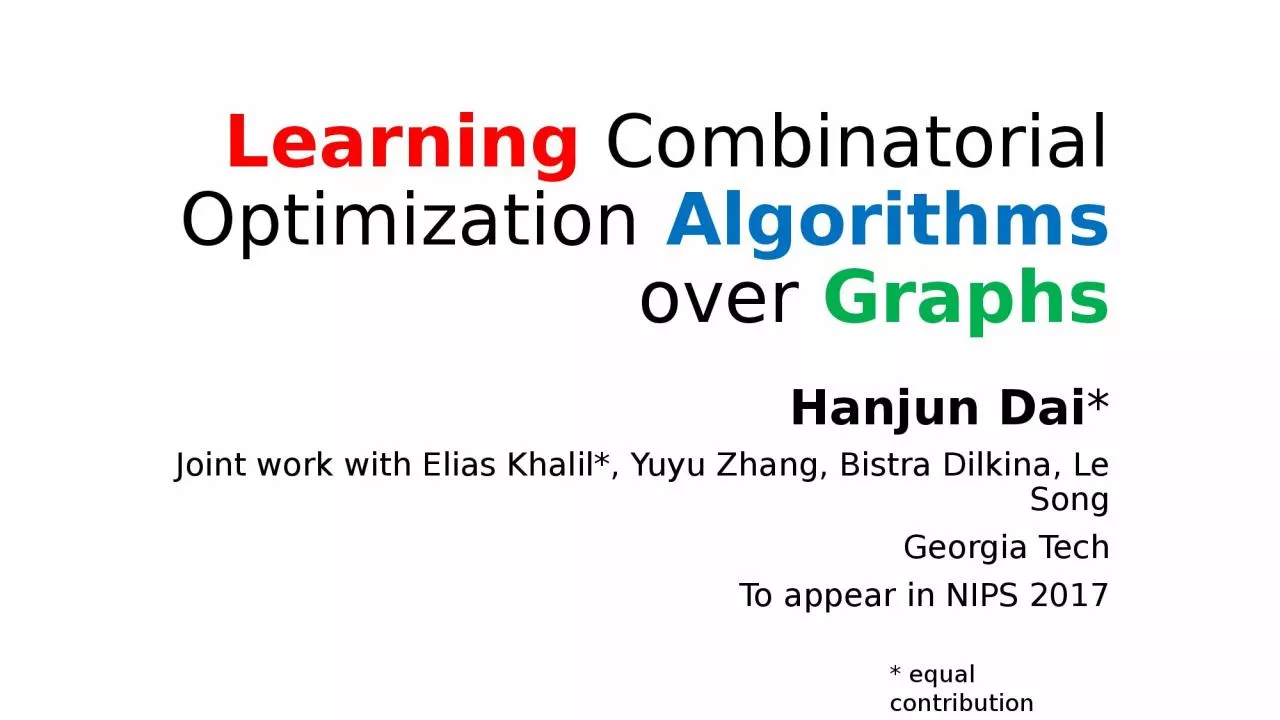

Optimization Algorithms over Graphs Hanjun Dai Joint work with Elias Khalil Yuyu Zhang Bistra Dilkina Le Song Georgia Tech To appear in NIPS 2017 equal contribution ID: 931710
Download Presentation The PPT/PDF document "Learning Combinatorial" is the property of its rightful owner. Permission is granted to download and print the materials on this web site for personal, non-commercial use only, and to display it on your personal computer provided you do not modify the materials and that you retain all copyright notices contained in the materials. By downloading content from our website, you accept the terms of this agreement.
Slide1
Learning Combinatorial Optimization Algorithms over Graphs
Hanjun Dai*Joint work with Elias Khalil*, Yuyu Zhang, Bistra Dilkina, Le SongGeorgia TechTo appear in NIPS 2017
*
equal contribution
Slide2A motivational exampleMinimum Vertex CoverFind smallest vertex subset S s.t. each edge has at least one end in S
2
Models advertising optimization in social networks
Slide3MotivationA realistic settingSame problem is solved repeatedly with slightly different
dataDelivery truck in Downtown Atlanta: Daily routing in the same area with slightly different customersDelivery in same road network with
slightly
different
conditions
3
Tackling NP-Hard problems
Design rationale
Exact algorithms
Tight formulations, good IP solvers
Approximation algorithms
Worst-case guarantees
Heuristics
Empirical performance
Can
classical algorithms exploit
the common
distribution
of instances?
Not automatically!
Slide4Proposal: Learning Greedy AlgorithmsMinimum Vertex Cover2-approx: greedily add vertices of edge
with max degree sum4
Goal
:
learn
a better
criterion
for greedy solution construction over a
graph distribution
Slide5Problem StatementMinimum Vertex
CoverMaximum Cut
Traveling Salesman Prob.
Insert
nodes into cover
Insert
nodes into subset
Insert nodes into sub-tour
5
Given a
graph optimization problem
and a
distribution
of problem instances, can we
learn better
greedy heuristics
that generalize to unseen instances from
?
Slide6Challenge #1: How to LearnPossible approach: Supervised learningGiven a partial solution, predict next vertex to add to solution
Data: collect (partial solution, next vertex) pairs features labelTask: multi-class classificationPointer Network[Vinyals, et al., NIPS 2015]: a smarter approach with recurrent neural networks6
PROBLEM
Need to compute good/optimal solutions to NP-Hard problems in order to learn!!
Slide7[Minh, et al. Nature 2015]
Greedy policy:
State
: current screen
Reward
:
score you earned at current step
Action value function
:
your predicted future total rewards
Action
:
move your board left / right
Policy
: How to choose your action
Reinforcement
Learning Background
Slide8Reinforcement Learning Formulation8
Repeat until all edges
covered:
Compute
score
for each vertex
Select vertex with
largest score
Add best vertex to cover
Reward:
State
: current selected nodes
Action
value function:
Greedy policy
:
Update state
Minimum Vertex Cover
SOLUTION
Improve policy by learning from experience => no need to compute optima
Slide9Reinforcement Learning Algorithm9
Sample graph instanceExplore or
Exploit
according to current policy
Update
state
Optimize
model parameters
:
model parameters
Depend on features
Slide10Challenge #2: How to RepresentAction value function:
Estimate of goodness of vertex
in state
Representation of
A feature vector that describes
in state
Possible approach:
Feature engineering
D
egree, 2-hop neighborhood size, other centrality measures
…
10
PROBLEMS
1-
Task-specific engineering
needed
2- Hard to tell what is a good feature
3- Difficult to generalize across diff. graph sizes
Slide11Deep Node Representations11
3
0
0
Non-linearity
:
Node’s own tag
Neighbors’ features
Neighbors’ edge weights
Updating feature vector
Repeat embedding
times:
1
1
:
model parameters
[Dai, et al., ICML 2016]
Slide12Deep Node Representations12
3
0
0
Non-linearity
:
Update feature vector
Repeat embedding
times:
1
1
:
model parameters
For each node:
Compute Q-value:
Sum-pooling over nodes
SOLUTION
1-
No feature engineering
needed
2- Features’ parameters
trained to be good
3
- Can handle
different graph sizes
Slide13Overall Framework13
Slide14Experimental Setup14
Minimum Vertex Cover (MVC)
Maximum Cut (MAXCUT)
Traveling Salesman Problem
(TSP)
Graph
types
Erdos-Renyi
(ER) or
Barabasi
-Albert (BA)
ER or BA
DIMACS generator; uniform grid or clustered
Solvers
ILP with CPLEX
IQP with CPLEX
Concorde
Feature embedding size: 64
Embedding iterations
: 3 to 5
Full details in paper
Slide15Results: Solution Quality [MVC - BA]15
approximation ratio
Our method is near-optimal,
barely visible.
Slide16Results: Solution Quality [MAXCUT - BA]16
Slide17Results: Solution Quality [TSP - clustered]17
Slide18Results: Realistic InstancesMemeTracker: graph of news propagation between media http://snap.stanford.edu/netinf/#data Physics: Ising
spin glass model http://www.optsicom.es/maxcut/#instances18
Slide19Results: Algorithm Behavior19
Slide20Results: Algorithm Behavior20
Slide21Learning graph opt: quantitative comparison
Train on small graphs with 50-100 nodesGeneralize to not only graphs from same distributionBut also larger graphs Approximation ratio < 1.007
Slide22Learning graph opt: time-solution tradeoff
Embedded MF
CPLEX
1st
CPLEX
2nd
CPLEX
3rd
CPLEX
4th
2-approx
2-approx +
Embedding
produces
algorithm
with good tradeoff
!
RNN
Generate 200
Barabasi
-Albert networks with 300 nodes
Let CPLEX produces 1
st
, 2
nd
, 3
rd
, 4
th
feasible solutions
Slide23ConclusionA learning framework that exploits graph structureApplies directly to many graph optimization problemsPromising tool for automated algorithm designNIPS Preprint:
https://arxiv.org/abs/1704.01665 Code: https://github.com/Hanjun-Dai/graph_comb_opt 23